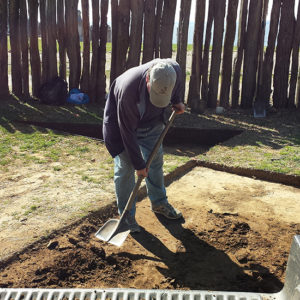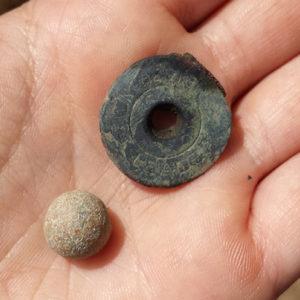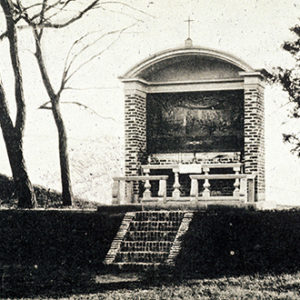Jamestown Rediscovery archaeologists have returned to an area outside the western palisade of James Fort where they worked a decade ago, near where they found the remains of Captain Bartholomew Gosnold, a principal promoter and vice admiral leader of the Jamestown colony.
It’s an area where “the whole Company every Saturday exercised, in the plaine by the west Bulwarke, prepared for that purpose, we called Smithfield: where sometimes more then an hundred Salvages would stand in an amazement to behold, how a fyle would batter a tree, where he would make them a marke to shoot at,” wrote John Smith in 1608.
A few musket balls have been found this month—but much of this area was scraped by laborers making earthen fortifications for Confederate forces at the beginning of the Civil War. And after the Association for the Preservation of Virginia Antiquities acquired the western side of Jamestown Island in 1893, caretaker William Leal had a house in this area.
Among the modern fill in the four open units are window glass fragments and a piece of a Winchester Repeater No. 12 shotgun shell (made between 1896-1938). Leal’s house was only 20 feet from the current excavations.
After Leal’s residence, the area featured the Hunt Shrine dedicated to the Reverend Robert Hunt (1568-1608), the first Anglican minister of the colony. The Colonial Dames of America in the State of Virginia erected it in 1922 to commemorate the earliest celebration of the Holy Communion in the first permanent English settlement in America.
Fellow settlers described Hunt as “an honest, religious and courageous divine, he preferred the service of God in so good a voyage to every thought of ease at home. He endured every privation, yet none ever heard him repine. During his life our factions were oft healed and our greatest extremities so comforted that they seemed easy in comparison with what we endured after his memorable death.”
The shrine was designed by Ralph Adams Cram, one of America’s premier Gothic Revival architects of the era. It frames a bas-relief depicting the 1607 service with two 16-foot-high brick pillars supporting a sandstone arch.
Jamestown Rediscovery Archaeologist Mary Anna Richardson said they have found part of the steps that once led to the shrine.
“We’ve got a more modern feature that has intact brickwork—a brick foundation—that is probably part of where the Robert Hunt Shrine used to be located. That Hunt Shrine was set into the earthworks which would have been just a little bit behind where Dan Smith is digging, towards where our palisade wall is now. This would have been the steps leading down from that Hunt Shrine,” she said.
In 1960 the shrine was rolled across the interior of Fort Pocahontas to be repositioned facing the river on the inward side of the northern earthwork, where it sits today to take advantage of a small amphitheater setting.
Richardson said the open units also show signs of two other features: a possible James Fort period feature and a dark soil stain with fragments of brick, bone and charcoal in it that may be a boundary ditch connected to such a ditch found during the previous excavations closer to the riverfront.
related images
- Breaking ground for 2014 dig season.
- Shotgun shell cap and musket ball found outside of the west palisade wall.
- The 2014 digging season began in an area the colonists referred to as Smithfield
- The Hunt Shrine in its original location.
- The Hunt Shrine in transit to its current location.










